Cameroceras is a genus of extinct, giant orthoconic cephalopod that lived mainly during the Ordovician period. It first appears during the middle Ordovician, around 470 million years ago, and was a fairly common component of the fauna in some places during the period, inhabiting the shallow seas of Laurentia, Baltica and Siberia. Its diversity and abundance became severely reduced following the Ordovician–Silurian extinction events, and the last remnants of the genus went extinct sometime during the Wenlock.
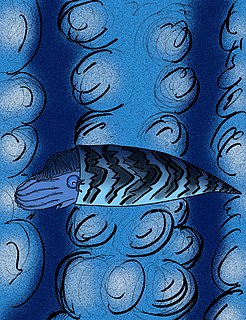
Nanno is an Endocerid, named by Clarke in 1894 for the apical end of an endocerid from the Trenton Limestone of New York state that has the basic description of the nanno type. It is possibly the senior synonym for Proterovaginoceras. As a valid genus, Nanno is included in the Endoceratidae but the nanno type apex may be found in other families.

Bellerophontoidea, common name "bellerophonts", is a superfamily of extinct planospirally-coiled globose molluscs. This superfamily is generally included within the Gastropoda, but may instead be a group of monoplacophorans. The taxon first appeared late in the Cambrian and continued until late in the Triassic.

Calliostoma selectum, common name the select maurea, is a species of medium-sized sea snail, a marine gastropod mollusc in the family Calliostomatidae, the calliostoma top snails.
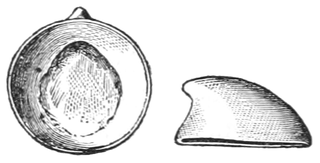
†Archinacellidae is an extinct family of paleozoic molluscs of uncertain position.

Scenella tenuistriata is an extinct species generally classified as a mollusc or hydrozoan in the family Scenellidae.
Bucaniidae is an extinct family of Paleozoic molluscs of uncertain position possibly being either gastropods or monoplacophorans in the superfamily Bellerophontoidea. The family lived from the Lower Ordovician to the Devonian and have shells in which the apertural margins tend to flare. Most genera have a slit and selenizone, others some modification of this feature.

Pilina unguis is an extinct species of Paleozoic Silurian monoplacophoran. It was first named as Tryblidium unguis and described by Gustaf Lindström in Latin from the Silurian deposits of Gotland in Sweden, in 1880.

Helcionopsis radiatum is an extinct species of paleozoic monoplacophoran in the family Tryblidiidae.

Helcionopsis is an extinct genus of paleozoic monoplacophoran in the family Tryblidiidae.
Helcionopsis subcarinata is an extinct species of paleozoic monoplacophoran in the family Tryblidiidae.
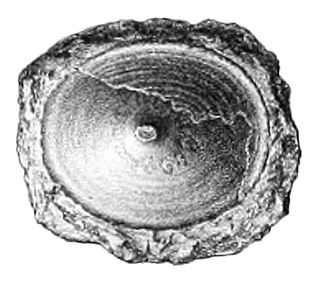
Pilina solarium is an extinct species of a paleozoic Silurian monoplacophoran. It was first named as Palaeacmaea solarium and described by Gustaf Lindström from Silurian of Gotland in Sweden in 1884.

Haliotis gigantea, common name the giant abalone, is a species of sea snail, a marine gastropod mollusk in the family Haliotidae, the abalones. It is known as Siebold's Abalone, after Philipp Franz von Siebold.
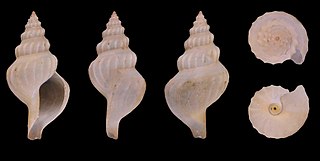
Pleurotomella packardii is a species of sea snail, a marine gastropod mollusk in the family Raphitomidae.

Lottia scabra or the rough limpet is a species of sea snail, a true limpet, a marine gastropod mollusk in the family Lottiidae.

Broderipia subiridescens is a species of sea snail, a marine gastropod mollusk in the family Trochidae, the top snails.
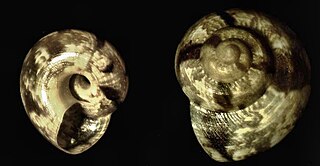
Ethminolia vitiliginea, common name the depressed top shell, is a species of sea snail, a marine gastropod mollusk in the family Trochidae, the top snails.

Potamolithus rushii is a species of freshwater snail with an operculum, an aquatic gastropod mollusk in the family Lithoglyphidae.

Spectamen semireticulatum is a species of sea snail, a marine gastropod mollusc in the family Solariellidae.
Phragmolites is an extinct genus of molluscs in the family Bucaniidae, paleozoic molluscs of uncertain position possibly being either Gastropods or Monoplacophorans in the superfamily Bellerophontoidea.















